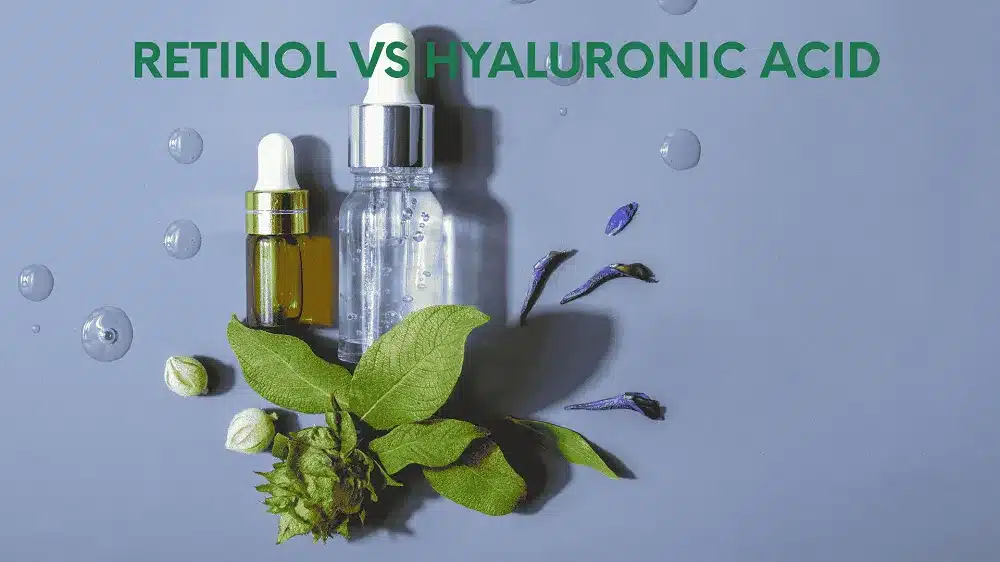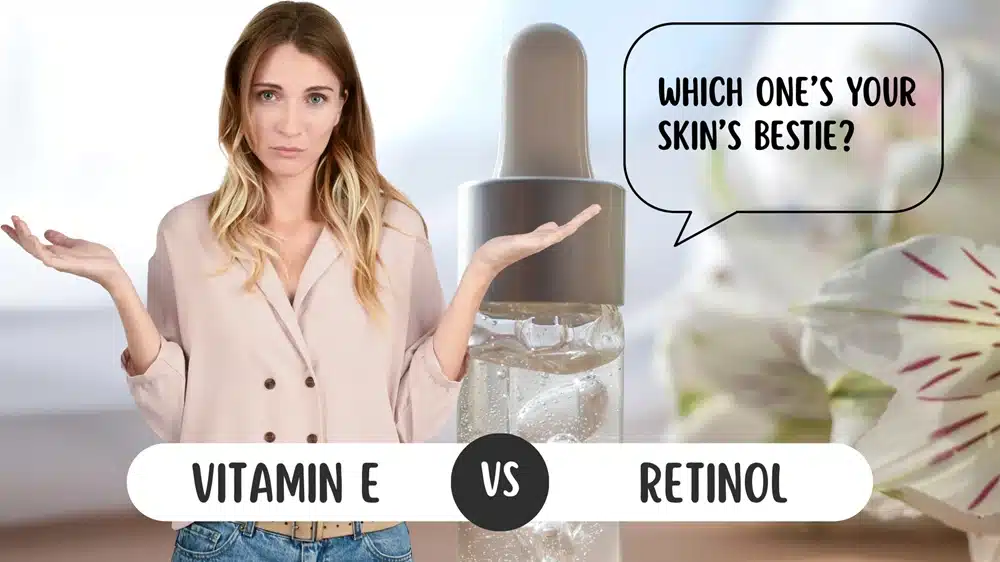In the world of skincare, Retinol vs Hyaluronic Acid is a hot topic, as both ingredients promise transformative results but cater to different needs. Retinol, a potent anti-aging powerhouse, tackles wrinkles and acne, while Hyaluronic Acid delivers unmatched hydration for plump, radiant skin. This article dives deep into their mechanisms, benefits, side effects, and practical applications to help you decide which ingredient—or combination—best suits your skin goals.
What is Retinol?
Retinol, a derivative of Vitamin A, is a retinoid celebrated for its transformative effects on skin. It penetrates the skin’s surface to accelerate cell turnover, shedding dead cells and promoting new ones. This process not only smooths the skin but also stimulates collagen and elastin production, which are critical for maintaining skin’s structural integrity. Retinol’s ability to target multiple concerns—from aging to acne—makes it a staple in dermatology.

Benefits of Retinol for Skin and Face
Retinol’s versatility stems from its ability to address both cosmetic and clinical skin issues:
- Reduces Fine Lines and Wrinkles: By boosting collagen, Retinol strengthens the skin’s foundation, visibly reducing facial wrinkles and crow’s feet over time.
- Improves Skin Texture and Tone: It refines rough patches and fades hyperpigmentation, such as sunspots or melasma, for a more even complexion.
- Combats Acne: Retinol unclogs pores by regulating oil production and preventing dead skin buildup, reducing blackheads and inflammatory acne.
- Enhances Radiance: Accelerated cell turnover reveals fresher skin, giving the face a brighter, more luminous glow.
- Firms Skin: Increased elastin and collagen production help counteract sagging, restoring a taut, youthful appearance.
Potential Side Effects of Retinol
Retinol’s potency comes with challenges. It can cause irritation, redness, and peeling, particularly during the first few weeks of use. This “Retinol purge” occurs as the skin adjusts to faster cell turnover, sometimes leading to temporary breakouts. Long-term, Retinol increases photosensitivity, making daily sunscreen non-negotiable to prevent UV damage. Those with sensitive skin may need lower concentrations or less frequent application to minimize discomfort.
Before and After Retinol Side Effects
- Initial Phase (Weeks 1–4): Expect redness, flaking, or mild stinging as the skin adapts. Acne may temporarily worsen as clogged pores clear out.
- Long-Term Use (Weeks 8–12 and Beyond): Side effects typically subside, revealing smoother, clearer skin with reduced wrinkles. Photosensitivity persists, requiring consistent sun protection to maintain results.
Retinol suits oily, acne-prone, or aging skin but demands patience and careful integration to avoid irritation.
What is Hyaluronic Acid?
Hyaluronik Asit is a naturally occurring polysaccharide found in the skin, connective tissues, and eyes. As a humectant, it attracts and retains water, holding up to 1,000 times its weight in moisture. This makes it a hydration hero, restoring plumpness and elasticity to the skin. Unlike Retinol, Hyaluronic Acid works on the surface to provide immediate, gentle hydration without altering cellular processes.
Benefits of Hyaluronic Acid
Hyaluronic Acid’s primary strength lies in its ability to hydrate and support skin health:
- Intense Hydration: It draws moisture into the skin, combating dryness and creating a dewy, supple texture.
- Improves Elasticity: Hydrated skin maintains better elasticity, reducing the appearance of fine lines and sagging.
- Universal Compatibility: Its non-irritating nature makes it suitable for sensitive, dry, oily, or acne-prone skin, offering hydration without clogging pores.
- Plumps Skin: By filling the skin with moisture, it smooths out fine lines, giving an immediate youthful effect.
Potential Side Effects of Hyaluronic Acid
Hyaluronic Acid is remarkably gentle, with minimal side effects in topical form. Rarely, it may cause mild irritation in hypersensitive individuals. In cosmetic fillers (sometimes referred to as “girth enhancement” for adding facial volume), Hyaluronic Acid injections can lead to temporary swelling, bruising, or localized redness. There is no credible evidence linking topical or oral Hyaluronic Acid to liver damage, making it a safe choice for most users when applied correctly.
Hyaluronic Acid is a go-to for anyone seeking hydration, especially those with dry, dehydrated, or sensitive skin.
Retinol vs. Hyaluronic Acid: Key Differences
Retinol and Hyaluronic Acid serve distinct roles in skincare, making them complementary rather than interchangeable. The table below highlights their differences in depth:
| Aspect | Retinol | Hyaluronik Asit |
|---|---|---|
| Birincil İşlev | Accelerates cell turnover, boosts collagen, targets aging and acne. | Hydrates and plumps skin by retaining moisture. |
| Mekanizma | Penetrates skin to stimulate cellular renewal and protein synthesis. | Acts as a humectant, binding water to the skin’s surface. |
| Skin Type Suitability | Best for oily, acne-prone, or aging skin; may irritate sensitive skin. | Universal; ideal for dry, sensitive, or combination skin. |
| Application Timing | Night use only due to photosensitivity. | Day or night, flexible for any routine. |
| Results Timeline | Visible results in 4–12 weeks; long-term commitment needed. | Immediate hydration and plumping; effects are temporary but cumulative. |
| Yan Etkiler | Irritation, redness, peeling; photosensitivity persists. | Minimal; rare irritation or swelling (in fillers). |
| Uyumluluk | Can be paired with hydrators like Hyaluronic Acid to reduce dryness. | Enhances other products; reduces irritation from actives like Retinol. |
Their synergy allows for combined use, with Hyaluronic Acid mitigating Retinol’s drying effects while enhancing overall skin health.
How to Use Them in Your Skincare Routine
Using Retinol and Hyaluronic Acid effectively requires strategic application to maximize benefits and minimize irritation.
Retinol Usage Tips
- Start Low and Slow: Begin with a 0.025% or 0.05% concentration, applying 1–2 times weekly to build tolerance. Gradually increase to nightly use if tolerated.
- Nighttime Application: Apply to clean, dry skin in the evening, followed by a moisturizer to lock in hydration and reduce irritation.
- Sun Protection: Use broad-spectrum SPF 30+ daily to protect against heightened UV sensitivity.
- Yama Testi: Apply to a small area (e.g., behind the ear) for 24 hours to check for adverse reactions before full use.
Hyaluronic Acid Usage Tips
- Apply on Damp Skin: Use after cleansing when skin is slightly damp to enhance moisture absorption.
- Layer with Moisturizer: Seal with a cream or lotion to prevent moisture loss, especially in dry climates.
- Flexible Timing: Incorporate into morning or evening routines, as it’s gentle and non-photosensitizing.
Combining Retinol and Hyaluronic Acid
These ingredients work well together when applied correctly. For sensitive skin, use Hyaluronic Acid in the morning and Retinol at night to avoid irritation. For tolerant skin, layer Hyaluronic Acid first to hydrate, followed by Retinol. A sample routine:
- Morning: Cleanser, Hyaluronic Acid serum, moisturizer, SPF 30+.
- Evening: Cleanser, Hyaluronic Acid serum (optional), Retinol (2–3 times weekly), moisturizer.
Start with a simple routine and adjust based on your skin’s response. Overuse of Retinol can exacerbate irritation, so monitor closely.
Yaygın Mitler ve Yanlış Anlamalar
Misinformation can cloud skincare decisions. Here are some myths debunked:
- Myth: Retinol Thins the Skin
Reality: While Retinol may cause initial peeling, it thickens the dermis by boosting collagen, improving skin resilience over time. - Myth: Hyaluronic Acid Is Only for Dry Skin
Reality: Its lightweight hydration benefits all skin types, including oily or acne-prone skin, without clogging pores. - Myth: Retinol and Hyaluronic Acid Can’t Be Used Together
Reality: They complement each other, with Hyaluronic Acid counteracting Retinol’s drying effects for a balanced routine.
Choosing the Right Ingredient for Your Skin Goals
Your skin concerns guide which ingredient to prioritize:
- Anti-Aging: Retinol is unmatched for reducing wrinkles, firming skin, and improving texture. Its ability to stimulate collagen makes it ideal for long-term rejuvenation of the face and neck.
- Hydration and Plumping: Hyaluronic Acid delivers instant moisture, smoothing fine lines and enhancing elasticity. It’s perfect for dehydrated or dull skin.
- Both Goals: Combine them for comprehensive care. Use Hyaluronic Acid to maintain hydration and Retinol for cellular renewal. Start with separate routines (e.g., Hyaluronic Acid morning, Retinol night) and consult a dermatologist if side effects persist or if tailoring for complex concerns like rosacea or severe acne.
Sonuç
Retinol and Hyaluronic Acid are skincare superstars with distinct strengths. Retinol transforms skin by tackling wrinkles, acne, and uneven texture through cellular renewal, while Hyaluronic Acid provides instant hydration and plumpness for a radiant glow. Together, they can address multiple concerns, offering a balanced approach to healthy skin. Experiment with these ingredients, start slowly, and consult a dermatologist for personalized guidance. What’s your experience with Retinol or Hyaluronic Acid? Share your thoughts in the comments!
Referanslar
- Gold, M. H. (2007). Use of hyaluronic acid fillers for the treatment of the aging face. Clinical Interventions in Aging, 2(3), 369–376.
- Kang, S., et al. (1995). Topical tretinoin (retinoic acid) improves early stretch marks. Archives of Dermatology, 131(5), 519–526.
- Kligman, A. M., et al. (1986). Topical tretinoin for photoaged skin. Journal of the American Academy of Dermatology, 15(4), 836–859.
- Litwiniuk, M., et al. (2016). Hyaluronic acid in inflammation and tissue regeneration. Wounds, 28(3), 78–88.
- Mukherjee, S., et al. (2006). Retinoids in the treatment of skin aging: An overview of clinical efficacy and safety. Clinical Interventions in Aging, 1(4), 327–348.
- Papakonstantinou, E., et al. (2012). Hyaluronic acid: A key molecule in skin aging. Dermato-Endocrinology, 4(3), 253–258.

